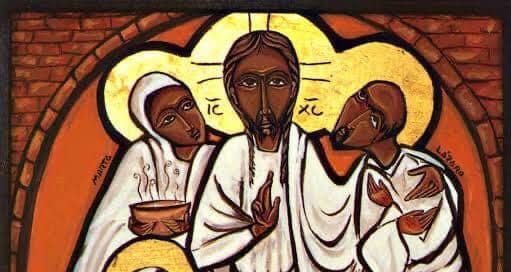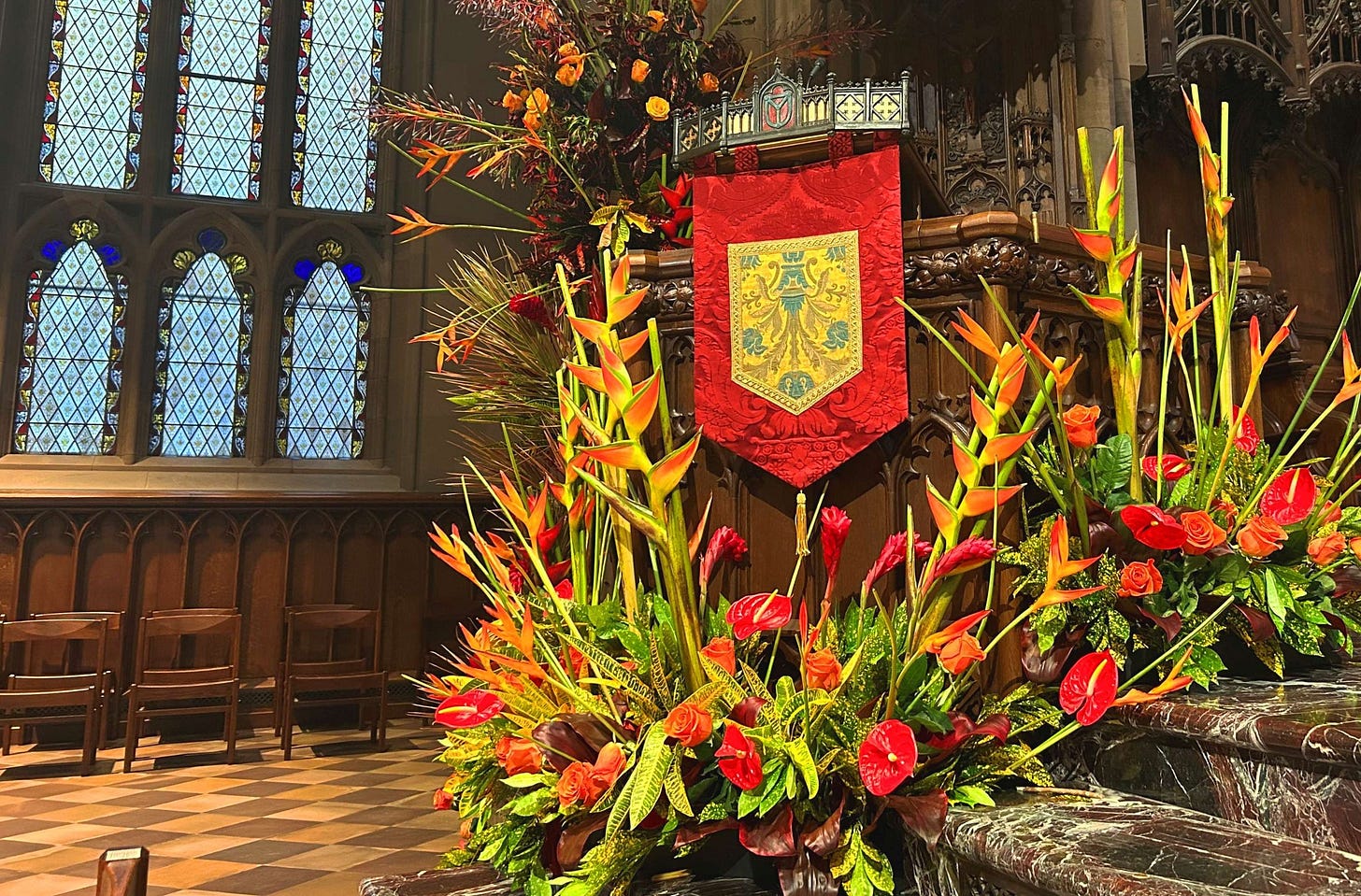Dear Friends,
What do you mean, there’s only one more Sunday before Holy Week?
Sure, sure, if you read this on the day it comes out, that “one more Sunday” is actually the better part of two full weeks, but still! Laetare Sunday has passed and Resurrection is nearly at hand. It’s a particularly fitting Sunday, I think, for its appointed letter from Paul – “forgetting what lies behind and straining forward to what lies ahead, I press on toward the goal for the prize of the heavenly call of God in Christ Jesus.”
That call is at hand.
Perfume & Poverty
Before we can get to Holy Week, though, we have another important stop in the lectionary – the story of Mary & Martha. I’m sure many of you grew up with those classics like “Having a Mary Heart in a Martha World.” I remember it as being the sort of book you could buy at KMart and copies littered thrift store shelves. It was a book that showed up in places that weren’t really about books.
That’s not all I remember, though. While this Sunday’s lectionary reading comes from the Gospel of John, it’s the text from Luke that stands out from my childhood, and the two offer us very different stories, ones certainly worth reading side-by-side with older children and youth. While certainly both texts try to judge Mary’s particular piety, they read rather differently.
In Luke, the text from my childhood brain (I’m sure I heard both, but such is the nature of memory), Martha is busily preparing the home – presumably to properly host Jesus and the disciples – while Mary goes to sit and listen to Jesus teach. In a strange way, the scene is a bit like last week’s Parable of the Prodigal Son; Martha turns to Jesus and demands that he make her sister help with the work. Jesus, of course, replies with that line that lives in my head: “She has chosen the better part.”
His full response, of course, is a bit more substantial. “Martha, Martha,” the Lord answered, “you are worried and upset about many things, but few things are needed—or indeed only one. Mary has chosen what is better, and it will not be taken away from her.” (Luke 10:41-42). The full text tries to shift the attention back to Jesus, to his teachings, the only thing that is needed, but of course that isn’t quite true. It may be true in the eternal sense, in our orientation toward “the prize of the heavenly call of God in Jesus Christ,” if we return to this week’s Epistle, but the disciples are still going to want dinner. Jesus is being a sort of annoying guest, to be honest.
In contrast to this passage, this week’s telling in John’s Gospel points us to a slightly different balance of things. Here, Martha’s service is not abjured, but simply observed as part of the whole tender scene. They are having a dinner and Martha is serving, the text says, whereas Luke describes her as variations of distracted and worried. These are very different things. Instead, in John, it is Judas who raises a complaint.
"Why was this perfume not sold for three hundred denarii and the money given to the poor?"
It’s honestly humorous. John condemn’s Judas in what, as least in the modernized text, is represented as parentheticals – you can hear him whispering to you about Judas’s upcoming betrayal, about his disregard for the poor. This is not about the poor, he sneers at Judas. But returning to Jesus, his response here is both the same and different from the Luke version. Here, he defends Mary again, but the words of personal shame are directed toward a bad actor, toward Judas rather than Martha, which makes a big difference. Thus, when Jesus says, “You always have the poor with you, but you do not always have me,” Jesus again reminds us about what is most important while also acknowledging the structures of faith and worship. We can serve the poor diligently (indeed you must) and we can also offer good things – the anointing oil as well as our attention – to God.
Part of this message, of course, is about the grace that redeems us; our love of God, our faithful devotion, is the most important thing because it is the only thing that can redeem us, that saves us. (My teen confirmation brain parrots “Saved by grace through faith.”) Returning to Luke: few things are needed - indeed, only one – which is not the same as saying the rest of the work is done. Both can be true.
The other part of the message is one that is a point of contention and reflection in the wider Church today. Why wasn’t the perfume sold and the money given to the poor? It’s not wrong to ask the same question about our parish flower or vestment budgets. Why spend all that money on appearances when it can be given to the poor? Well, the answer is that these materials and symbols are part of how we honor God. We can offer prayer and praise anywhere, but there is value in setting a place apart for that devotion, which is what the space of the church does.1 How we treat something communicates – offers an unspoken lesson about – how we value it. That means caring for the symbols of our faith with the care of Martha anointing Jesus’s feet with perfume, wiping them with her hair
Such shows of beauty stretch across faith traditions. Consider the finials placed on Torah scrolls, which are often made of silver and adorned with bells or flowers offered at Buddhist temples. Even the prayer rugs used during the five daily calls to prayer in Islam may be art; though they are not technically essential and their stated purpose is primarily functional, keeping the person clean during their prayers, they may also feature intricate designs and be cared for and passed down over many years.
When we set an altar at home or at church, when we create spaces to worship and to learn, beauty matters. Which brings me to one last thing –
Beauty & Chaos
When a church school class is running particularly well and in such an orderly manner, or when somehow all the pieces of the Holy Week services (maybe even a live donkey) come together, it’s easy for us to to see only the beauty. It is, in many ways, like the illusion of social media: especially from the outside, we only see the perfect moments, not the things that went awry.
Sometimes, as a Godly Play trainer and someone with may friends in that space and in Catechesis of the Good Shepherd, we find ourselves being Montessori pitch-men, as it were. We’re out here trying to explain order and beauty and the child-focused and child-led space and we’re met with a sort of disbelief. It’s the contradiction a recent Atlantic article about Montessori’s contemporary (and never licensed/copyrighted) expression describes. Social media Montessori influencers are presenting this perfect vision of their orderly lives with their independent children and we as Christian educators can sound, in our descriptions of this work, like we also have some secret.
It’s not a secret. There is still chaos. None of this generates perfect (AKA imaginary) children. But anxiety creeps in because other adults would prefer we placed greater pressure on these space to maintain control. They don’t trust children and so they want us to hold tighter.
I think we’re holding hands, instead. We’re following the child in a way that provides them with a secure anchor, not following them while they run toward a cliff.
I think about the traditional Montessori work of flower arranging, which remains popular in Catechesis of the Good Shepherd, and how this is an introduction to creating beauty that flows directly into the work of our altar and flower guilds. The church is a prepared environment for, typically, adult meaning making. As we head into Holy Week, into some of the most intensive management of our worship practices in the church year, how are we helping children and youth participate not just in the worship practices of this time, but in the creation of these spaces? How are we, with preparation, inviting them into these ministries?
Resource Round-Up
New or not-so-new this week - Holy Week first, then the other stuff.
Need your Palm Sunday coloring palm frond? Grab that from Illustrated Ministry here!
It’s a good time to review this talk on theologies of the cross with Traci Smith, Daneen Akers, and Herb Montgomery.
Catechesis Books has Holy Week emotions coloring sheets that go with the Holy Week primer board book.
I love this simple Prayer Walk for preparing for Holy Week from Sparkhouse. It has the potential to be a really beautiful way of preparing those who serve in hospitality roles for a time when our churches see many visitors or members who aren’t in frequent attendance. At the same time, it is tied to the events of Holy Week and the structure of the church space and liturgy.
I make a point of not asking my parish’s music minister to do anything extra during Holy Week, which means my special Good Friday program is a Taize chant or other paperless music and, if I’m looking for some background gathering tunes, Page CXVI’s Good Friday to Easter album –
Have you checked out the GenOn Resource Library? Their Parenting and Spiritual Formation and Families in Faith Libraries are overflowing with ideas and tools. Scroll down past the project information and pick the Resource Library that interests you – it’s free to sign-up. They’ll text you each week with ideas for exploring your values as a family and making those ordinary moments holy.
Rend Collective, one of my favorites, has released FOLK! (pt. 2) - it’s maybe more of an Easter listen, but the delight is here now nonetheless.
That’s it for now, folks. Let’s soak up this week and next before we arrive at Palm Sunday. We are headed toward resurrection, but not there yet.
Peace,
Bird
I highly recommend this article on the Spirituality of the Flower Guild at Washington National Cathedral.






